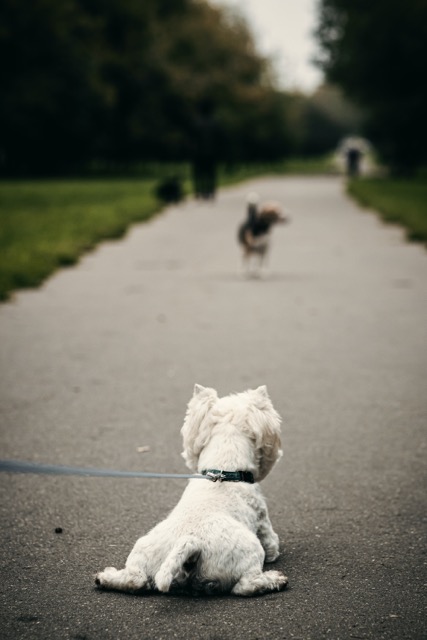Growling and vocalizing are one of the many ways puppies communicate. It can be challenging for owners to decode their puppy’s growl. Although knowing what a puppy is trying to say is never 100% foolproof, I rely on context, the immediate environment, and other correlated messages to tell me what a puppy’s growl is communicating.
Growling During Play

Most of the time, when puppies growl, it is appropriate and a form of play. Growling is often accompanied by play-biting, chasing, and bounding with endless energy. Most puppy growling during play is perfectly appropriate, and it is common for puppies to growl when wrestling or playing tug of war. Growling in this context is correlated with bouncy behavior and is a signal to others to come to play. Sometimes, the play gets too intense and needs to be interrupted to prevent problem behaviors from developing. These times usually involve longer durations of overly physical play. A small 30-second cooldown is typically enough to keep puppy behavior in check! Puppies can go back to playing, growling, and bounding until another cooldown period is deemed necessary by an owner.
Growling When Picked Up or Moved
It is normal for puppies to be wiggly and even grunt a bit when picked up. They may lick and start play-biting during the exchange. One form of puppy growling concerning me as a Certified Applied Animal Behaviorist is stiffening and growling as a puppy is picked up. This type of growling needs an intervention.
I recommend having the puppy drag a leash indoors and putting a training plan in place. The training plan involves having an adult owner pick up the puppy 15-20 times daily. When the puppy is picked up, they are immediately fed a treat and back down. Every so often, approximately every third time, the same exercise is done, except the puppy is held longer, lengthening their duration. Treats are continuously fed throughout. This is repeated for 7-10 days. Then, assuming the growling is no longer occurring, exercises are introduced with other adults and responsible, known children over 10. Continue pairing any physical manipulation of the puppy’s body with a tasty treat.
Similar exercises can be done if a puppy growls while nudging or moving. The puppy is allowed to get comfortable while resting, they are approached, gently nudged, immediately fed a treat, and the owner walks away. Again, the exercise is started with an adult owner while other adults are slowly incorporated once the puppy is no longer growling. And do not worry, growling will not be unintentionally rewarded—it is impossible to do with this exercise!
Growling as Strangers Pass or Approach

Young puppies 8-16 weeks should wiggle with excitement when strangers pass nearby or approach to talk to them. Licking, biting, and jumping are all likely to soon ensue. A puppy’s behavior should reflect very friendly, and after the greeting, they may even start to bark for attention if they get ignored. This friendly greeting is typical puppy behavior. Letting out low growls as strangers pass, or approach is abnormal and should not be taken lightly. If a puppy growls at strangers as strangers attempt to greet them, it should serve as a call to action.
I recommend heavy socialization using classical conditioning. As strangers approach, handlers begin feeding the puppy tasty treats. Once the stranger is within reach and before any interaction, the stranger can be handed several treats. The stranger can then repeatedly feed the puppy one treat at a time. Instructing the stranger not to pet your puppy can be helpful as this can counteract your attempts to associate treats with new people positively. If handlers keep this up with 20 new people per week, that low growl will be turned into a wiggle in no time!
While growling outside of play is abnormal puppy behavior, it does not mean a life sentence for a puppy. Although serious in nature, behavior can and will change with proper treatment! Early intervention is key, especially when it comes to severe puppy behavior. In some cases, it is helpful to hire a professional to guide you through the appropriate steps. If owners find and use an excellent treatment plan, the puppy can lead a long, happy, and successful life in their forever home!




